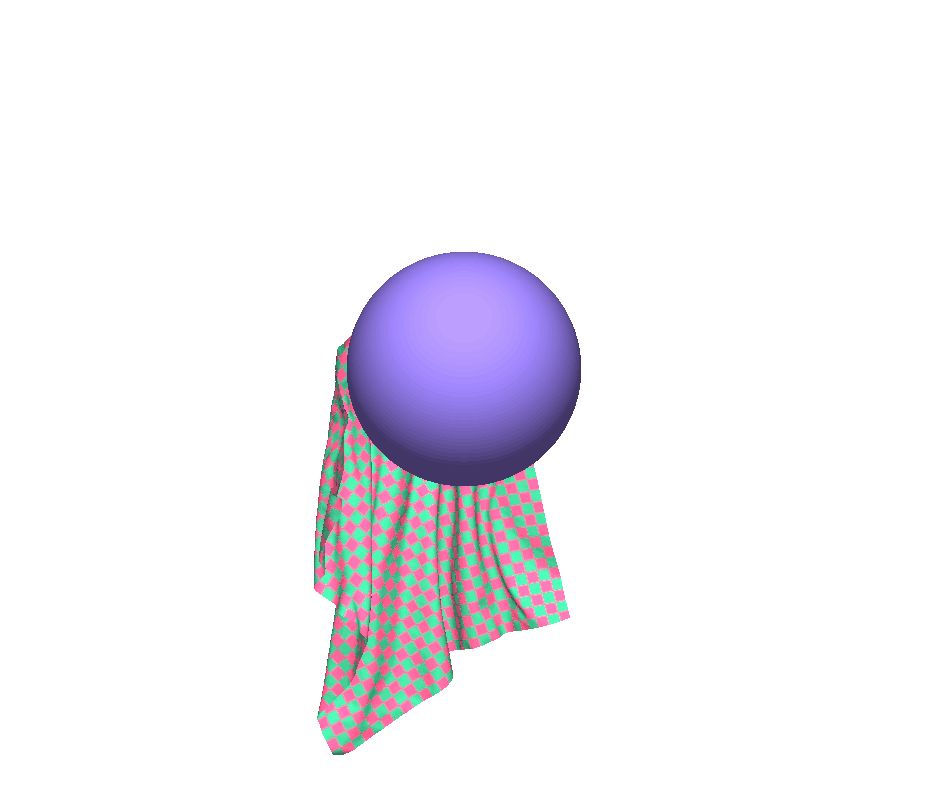这个神器,让我的 Python 代码运行速度快了100倍
Python 已经得到了全球程序员的喜爱,连续多期稳坐编程语言排行榜第一把交椅。但是还是遭到一些人的诟病,原因之一就是认为它运行缓慢。 要是有一款能够自动优化我们代码的神器该有多好啊!
于是,大家都在想尽各种办法来提高 Python 代码的运行速度,大多数体现在写代码的习惯优化以及代码优化上。但是平时写代码注意太多这些方面可能会有糟糕的体验,甚至会不利于我们的工作效率。
今天就给大家带来这样的一款神器——taichi,喜欢记得收藏、点赞。
文章目录
- taichi
- 技术提升
- 安装
- 一个小例子
- 用 Taichi 进行物理模拟
- 总结
taichi
Taichi 起步于 MIT 的计算机科学与人工智能实验室(CSAIL),设计初衷是便利计算机图形学研究人员的日常工作,帮助他们快速实现适用于 GPU 的视觉计算和物理模拟算法。
说人话就是 Taichi 是一个基于 Python 的领域特定语言,专为高性能能并行计算设计。
本来是服务于学术界的一款 DSL ,但是我们也可以拿来用在我们这些凡夫俗子的代码中(虽然有点大材小用)!
技术提升
文章源码、数据、技术提升都轻松获取,本文来自粉丝群小伙伴授权分享,可以加入我们,目前开通了技术交流群,群友已超过2000人,添加时最好的备注方式为:来源+兴趣方向,方便找到志同道合的朋友。
方式、添加微信号:dkl88191,备注:来自CSDN +python
方式、微信搜索公众号:Python学习与数据挖掘,后台回复:加群
安装
Taichi 是一个 PyPI 包,所以使用 pip 命令即可安装:
pip install taichi
注意 taichi 安装的先决条件是:
-
Python: 3.7/3.8/3.9/3.10 (64-bit)
-
OS: Windows, OS X, and Linux (64-bit)
在使用命令安装的时候,如果遇到错误,可以使用管理员模式命令行进行安装。
一个小例子
我们先来用一个小栗子,感受一下它的鬼斧神工!
import timedef is_prime(n):result = Truefor k in range(2, int(n**0.5) + 1):if n % k == 0:result = Falsebreakreturn resultdef count_primes(n: int) -> int:count = 0for k in range(2, n):if is_prime(k):count += 1return countt0 = time.time()
print(count_primes(100000))
t1 = time.time()print(t1-t0)
这个是我们以前经常用来做例子的统计质数个数。求100000以内速度比较快,但是到了1000000,运行时间就明显慢了下来,竟然需要3.38秒。
Python 的大型 for 循环或嵌套 for 循环总是导致运行时性能不佳。
我们只需导入 Taichi 或切换到 Taichi 的 GPU 后端,就能看到整体性能的大幅提升:
import time
import taichi as titi.init()@ti.func
def is_prime(n):result = Truefor k in range(2, int(n**0.5) + 1):if n % k == 0:result = Falsebreakreturn result@ti.kernel
def count_primes(n: int) -> int:count = 0for k in range(2, n):if is_prime(k):count += 1return countt0 = time.time()
print(count_primes(1000000))
t1 = time.time()print(t1-t0)
在这里,我们只需要引入 taichi 库,然后加两个注解,速度直接飙到了0.1秒,速度提升了30多倍。如果我们把数字再扩大,速度提升会更明显!
没有使用之前,统计10000000以内质数使用 90 秒,使用之后,并且更改为 GPU 运行,使用 0.1秒。
我们还可以将 Taichi 的后端从 CPU 更改为 GPU 运行:
ti.init(arch=ti.gpu)
用 Taichi 进行物理模拟

上面的动图很好地模拟了一块布料落到一个球体上。动图中的布料建模使用了弹簧质点系统,其中包含 10,000 多个质点和大约 100,000个弹簧。模拟如此大规模的物理系统并实时渲染绝不是一项容易的任务。
Taichi 让物理模拟程序变得更易读和直观,同时仍然达到与 C++ 或 CUDA 相当的性能。只需拥有基本 Python 编程技能,就可以使用 Taichi 用更少的代码编写高性能并行程序,从而关注较高层次的算法本身,把诸如性能优化的任务交由 Taichi 处理。
我们直接上源代码:
import taichi as ti
ti.init(arch=ti.vulkan) # Alternatively, ti.init(arch=ti.cpu)n = 128
quad_size = 1.0 / n
dt = 4e-2 / n
substeps = int(1 / 60 // dt)gravity = ti.Vector([0, -9.8, 0])
spring_Y = 3e4
dashpot_damping = 1e4
drag_damping = 1ball_radius = 0.3
ball_center = ti.Vector.field(3, dtype=float, shape=(1, ))
ball_center[0] = [0, 0, 0]x = ti.Vector.field(3, dtype=float, shape=(n, n))
v = ti.Vector.field(3, dtype=float, shape=(n, n))num_triangles = (n - 1) * (n - 1) * 2
indices = ti.field(int, shape=num_triangles * 3)
vertices = ti.Vector.field(3, dtype=float, shape=n * n)
colors = ti.Vector.field(3, dtype=float, shape=n * n)bending_springs = False@ti.kernel
def initialize_mass_points():random_offset = ti.Vector([ti.random() - 0.5, ti.random() - 0.5]) * 0.1for i, j in x:x[i, j] = [i * quad_size - 0.5 + random_offset[0], 0.6,j * quad_size - 0.5 + random_offset[1]]v[i, j] = [0, 0, 0]@ti.kernel
def initialize_mesh_indices():for i, j in ti.ndrange(n - 1, n - 1):quad_id = (i * (n - 1)) + j# 1st triangle of the squareindices[quad_id * 6 + 0] = i * n + jindices[quad_id * 6 + 1] = (i + 1) * n + jindices[quad_id * 6 + 2] = i * n + (j + 1)# 2nd triangle of the squareindices[quad_id * 6 + 3] = (i + 1) * n + j + 1indices[quad_id * 6 + 4] = i * n + (j + 1)indices[quad_id * 6 + 5] = (i + 1) * n + jfor i, j in ti.ndrange(n, n):if (i // 4 + j // 4) % 2 == 0:colors[i * n + j] = (0.22, 0.72, 0.52)else:colors[i * n + j] = (1, 0.334, 0.52)initialize_mesh_indices()spring_offsets = []
if bending_springs:for i in range(-1, 2):for j in range(-1, 2):if (i, j) != (0, 0):spring_offsets.append(ti.Vector([i, j]))else:for i in range(-2, 3):for j in range(-2, 3):if (i, j) != (0, 0) and abs(i) + abs(j) <= 2:spring_offsets.append(ti.Vector([i, j]))@ti.kernel
def substep():for i in ti.grouped(x):v[i] += gravity * dtfor i in ti.grouped(x):force = ti.Vector([0.0, 0.0, 0.0])for spring_offset in ti.static(spring_offsets):j = i + spring_offsetif 0 <= j[0] < n and 0 <= j[1] < n:x_ij = x[i] - x[j]v_ij = v[i] - v[j]d = x_ij.normalized()current_dist = x_ij.norm()original_dist = quad_size * float(i - j).norm()# Spring forceforce += -spring_Y * d * (current_dist / original_dist - 1)# Dashpot dampingforce += -v_ij.dot(d) * d * dashpot_damping * quad_sizev[i] += force * dtfor i in ti.grouped(x):v[i] *= ti.exp(-drag_damping * dt)offset_to_center = x[i] - ball_center[0]if offset_to_center.norm() <= ball_radius:# Velocity projectionnormal = offset_to_center.normalized()v[i] -= min(v[i].dot(normal), 0) * normalx[i] += dt * v[i]@ti.kernel
def update_vertices():for i, j in ti.ndrange(n, n):vertices[i * n + j] = x[i, j]window = ti.ui.Window("Taichi Cloth Simulation on GGUI", (1024, 1024),vsync=True)
canvas = window.get_canvas()
canvas.set_background_color((1, 1, 1))
scene = ti.ui.Scene()
camera = ti.ui.make_camera()current_t = 0.0
initialize_mass_points()while window.running:if current_t > 1.5:# Resetinitialize_mass_points()current_t = 0for i in range(substeps):substep()current_t += dtupdate_vertices()camera.position(0.0, 0.0, 3)camera.lookat(0.0, 0.0, 0)scene.set_camera(camera)scene.point_light(pos=(0, 1, 2), color=(1, 1, 1))scene.ambient_light((0.5, 0.5, 0.5))scene.mesh(vertices,indices=indices,per_vertex_color=colors,two_sided=True)# Draw a smaller ball to avoid visual penetrationscene.particles(ball_center, radius=ball_radius * 0.95, color=(0.5, 0.42, 0.8))canvas.scene(scene)window.show()
感兴趣的可以具体看看代码的实现过程,如果不加 taichi 库,这段代码运行起来会有点吃力,但是上了 taichi 之后,运行效果是如此丝滑!
总结
这个库是中国人发明的,它就是毕业于清华大学,后来去麻省理工学院进修的胡渊鸣
上一篇:【python】基础复习
下一篇:45-命令行基础操作